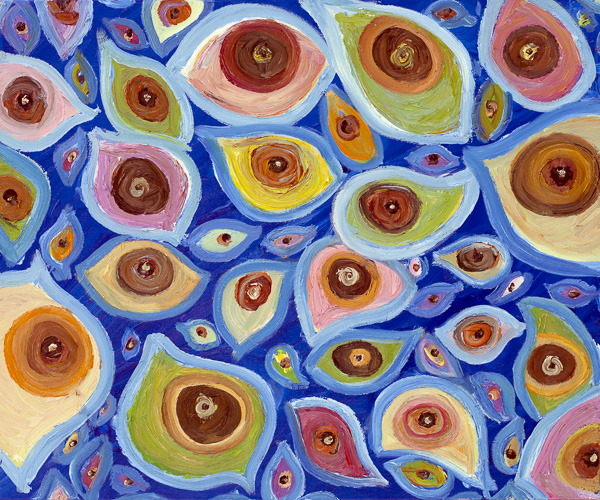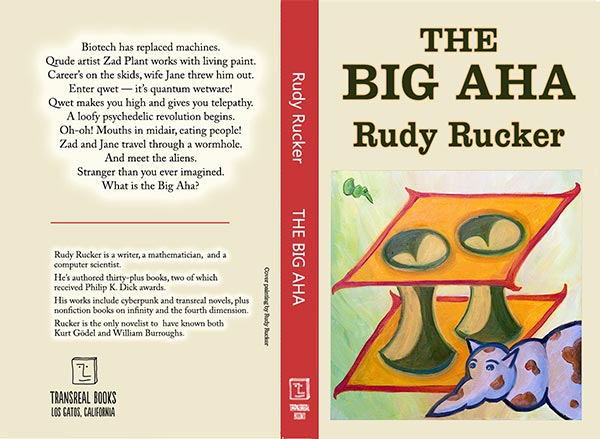So The Big Aha is selling and getting out there. Nice post on it by Cory Doctorow in Boing Boing.
I’ve been working with publishing ebooks and paperback POD (print on demand) books for nearly two years now. It’s been a long learning process, and I’m nowhere near done. Like hacking my way through a jungle with a machete.
Generally, the best way to get an answer to a question is to Google search with the main words of your question and look through the links that you find. The official help files for given software products aren’t always the best sources of info.
As a public service I thought I’d make the following links available. I’ve grouped them into two sections: Epublishing and POD Publishing. I like to keep my links alphabetized, so I’ve prefixed the titles of my most-used links with “AAA.”
Last updated November 19, 2013. Permanent version of this post is online at
www.rudyrucker.com/pdf/ebook_pod_bookmarks.html

The categories listed include:
Calibre (free program for converting between EPUB, HTML, and MOBI)
Dreamweaver (Adobe program for working with HTML files)
Lulu, NOOK, and KDP (ebook distributors)
CreateSpace and Lightning (POD book distributors)
ID (InDesign, Adobe program for designing print books)
There ought to be some links for Sigil (free program for creating EPUB files), but there aren’t.
Some of my early musings on Ebooks can be found in my ebook, How To Make An Ebook. See also my series of blog posts on the same topic. I’m so worn out from making my The Big Aha, that I don’t have the energy to write a How To Make A POD Book. So for now this list of links must suffice.
Have fun. If you can call this kind of thing fun…
—Rudy
-
Epublishing
- AAA E-junkie (Sellers) – Admin
- AAA ISBN My Identifiers | Bowker | Identifier Services
- AAA KDP (Kindle Direct Publishing): Bookshelf
- AAA Lulu
- AAA NOOK Press
- Adobe – Digital Editions
- BARNES & NOBLE | Rudy Rucker
- Calibre User Manual
- Dreamweaver Troubleshooting links
- ebook how to – CNET Reviews
- Ebook Conversion — calibre User Manual
- Ebook convert straight quotes to curly quotes
- eBook Formatting Paul Salvette in Bangkok:
- Ebook, making your text Kindle-Friendly
- Ebook: EPUB, MOBI, AZW and PDF Formats
- Ebook: Fonts used in various eReaders?
- Ebook: Fonts, CSS Font Stack
- EPUB A Basic Sigil Tutorial
- EPUB adding to iBooks via ITunes
- Epub avoid split into several html files? – MobileRead Forums
- Epub Format Construction Guide – HXA7241 – 2007
- EPUB Open Packaging Format (OPF) 2.0.1 v1.0
- EPUB Overview — Sigil v0.4.1 documentation
- ePub putting on Your iPad
- Epub Reader For Windows 7
- EPUB Reader Windows Software
- EPUB Sigil Splitting Pages
- EPUB tables MobileRead
- EPUB to MOBI Conversion [Left Margin Problem] « Morning Cup O’ Joe
- Font Size and Color — Support — WordPress.com
- HTML – image as large as possible
- HTML Anchor Bookmark Tag Links
- HTML CSS Cheatsheet
- HTML Fix Dreamweaver problem with large DOC import
- HTML for the Kindle with Blockquote
- HTML for the Kindle with Blockquote
- HTML into ebook Sample Code
- HTML online preview TryIt Editor
- HTML td tag
- ISBN buy and use at MyIdentifiers.com
- Kindle Cover Size
- Kindle eBook how to| Amazon Kindle 3 and Kindle DX Review and News Blog
- Kindle from PDF
- Kindle Guide Flags in a MOBI. “Start”
- Kindle OPF, Guide
- kindle-guide.pdf (application/pdf Object)
- Lulu Book Distribution
- PDFs splitting into multiple documents
- Piracy Alert (Scribd)

POD Publishing
- AAA Lightning Source Log In
- AAA Log In – CreateSpace
- AAA Login ISDN on Bowker
- Amazon Author Central
- Color Acrobat 9: Output Preview and Conversion « Layers Magazine
- Color. ID PDF, Pantone colours look dull in Acrobat Professional
- Color: AdobeRGB, sRGB or what?
- Color: Work Process for Best Colors…
- CreateSpace Bleed on Cover Template
- CreateSpace Book Cost Calculator
- CreateSpace Community: Creating a PDF for Print
- CreateSpace Gutter Margin
- CreateSpace Margins
- CreateSpace Post Editorial Reviews on Amazon
- CreateSpace Pre Order sales
- Createspace vs. Lightning Source Costs
- Createspace., Craddock’s Be Not Content
- CreateSpace: Cover Template
- CreateSpace: Self Publishing and Free Distribution for Books, CD, DVD
- CS Entering addresses to ship to customers?
- Dreamweaver: “Clean Up Word HTML” Error
- htaccess file for limiting access to a directory
- ID Anchor A Graphics Frame
- ID Baseline Grid
- ID Chapter names in header
- ID crashes at startup
- ID Creating book files
- ID EPUB CS6 Export as EPUB
- ID EPUB Exporting EPUB
- ID Export to HTML
- ID Fix Italic Overrides
- ID Flow: Adding Text with Flow
- ID Flow: Why is Smart Text Reflow so hard?
- ID Headers
- ID Highlight Overrides Script
- ID How to Anchor Objects InDesign (not very helpful)
- ID Import Graphics
- ID Import Styles
- ID Import Word file
- ID Improve justified type settings
- ID insert page spreads–Allow Pages To Shuffle
- ID Justification
- ID Keep Words Together with No Break
- ID Keyboard shortcuts
- ID Laying out frames and pages
- ID Making a Book file (video)
- ID Margin Sizes
- ID Margins and Columns
- ID Master pages
- ID optical margin
- ID Optical Margin
- ID Page Numbering Tricks
- ID Place graphics in a graphics frame
ID Print/Don’t Print Frame Outline - ID Remove Defaults and Saved Data
- ID Running Header Text Variables Chap Title
- ID save as Ebook
- ID Suggested Layout Tips
- ID Table Of Contents
- ID Tabs and indents
- ID Thread and Flow Text
- ID Unlink a text file (the hard way)
- ID Use Odd Page Break between Chaps
- ID Why ugly <span> tags in EPUB Export? Local overrides.
- ID Working with graphics frames
- ID Working with Word and InDesign
- Image Word Resize Image Macro
- InDesign Page numbering
- Indie Author: Lulu vs. CreateSpace: Which Is More Economical For The DIY Author?
- Lightning Color Shephard New 2013
- Lightning / CreateSpace Pricing: Shepard Plan B (old)
- Lightning / CreateSpace Pricing: Shepard Plan C (new)
- Lightning B&W pricings
- Lightning Book Cost Calculator
- LIghtning Color prices
- Lightning cover template
- Lightning Creation Guide
- Lightning Source 101 (Lightning Source Inc., print on demand, self publishing companies)
- Lightning Standard vs Premium Color
- MONKEYBRAINS – Support – Basic Auth
- Proof Better-Looking Full Justification for Paragraphs in WORD
- Proof Remove dupicate words in WORD
- PS Em dash and en dash in Photoshop text — Photoshop for Windows — ClearPS.com
- PS Fixed size selection
- Reviews (Booklist Online)
- Reviews (Library Journal)
- Reviews (Publisher’s Weekly)
- Rudy’s Blog Making a High-Quality Picture Book
- Word: Removing Unused Styles



















